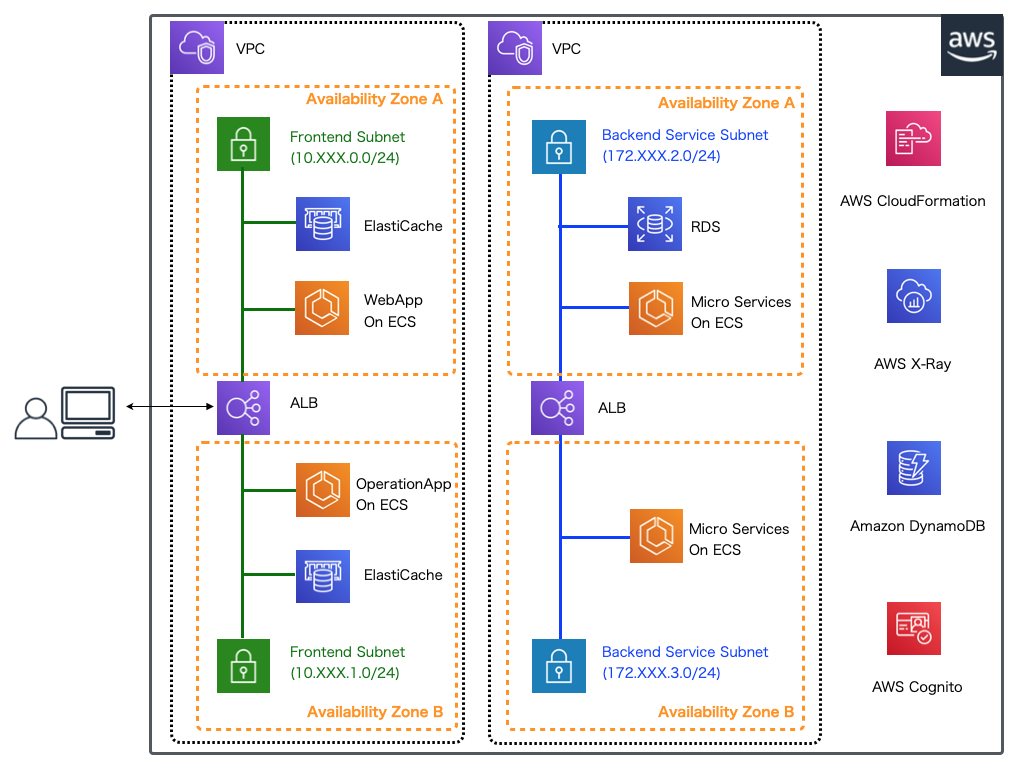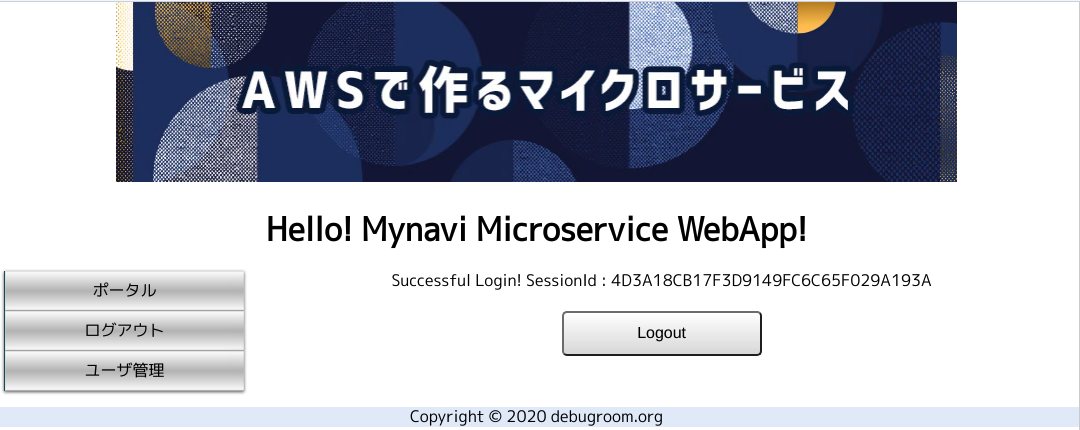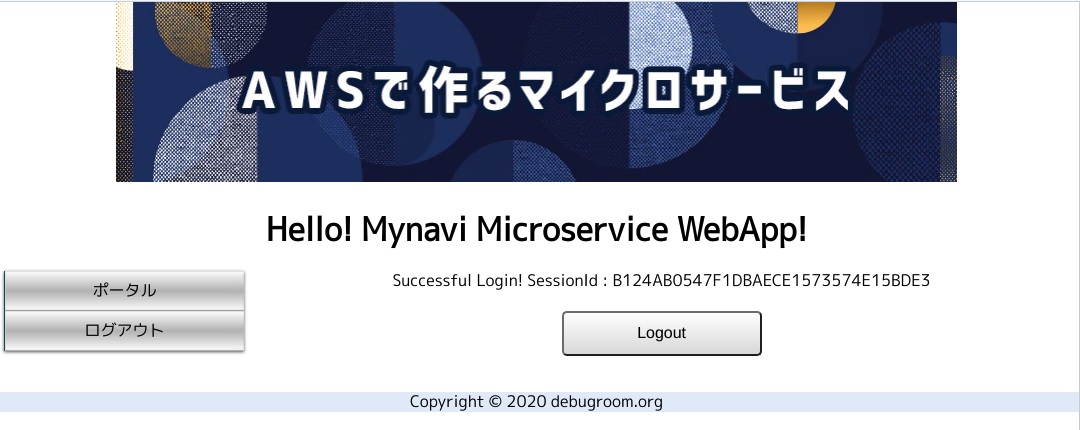【第7回】Webアプリケーションからマイクロサービスを呼び出す実装(2)¶
本連載では、以下に示すようなマイクロサービスアーキテクチャのアプリケーション環境を構築しています。

前回は第3・4回で作成したWebアプリケーション内で、バックエンドのマイクロサービスを呼び出す処理を実装しました。 今回は、取得したユーザリソースを使って認証処理を行うようアプリケーションを修正してみます。 なお、本連載で実際に作成するアプリケーションでは GitHub 上にコミットしています。 以降に記載するソースコードでは、import文など本質的でない記述を省略している部分があるので、実行コードを作成する際は、必要に応じて適宜GitHubにあるソースコードも参照してください。
Spring Securityを使ったWebアプリケーションの修正(2)¶
第4回で実装したCustomUserDetailsServiceから前回実装したOrchestrationServiceを呼び出すように変更します。 以前の実装はコメントアウトしています。UserResourceを取得して、プロパティisAdminの値に応じて、設定するGrantedAuthorityを変更します。
package org.debugroom.mynavi.sample.aws.microservice.frontend.webapp.app.web.security;
import org.debugroom.mynavi.sample.aws.microservice.common.apinfra.exception.BusinessException;
import org.debugroom.mynavi.sample.aws.microservice.common.model.UserResource;
import org.debugroom.mynavi.sample.aws.microservice.frontend.webapp.domain.repository.UserResourceRepository;
import org.debugroom.mynavi.sample.aws.microservice.frontend.webapp.domain.service.OrchestrationService;
import org.springframework.beans.factory.annotation.Autowired;
import org.springframework.context.MessageSource;
import org.springframework.security.core.GrantedAuthority;
import org.springframework.stereotype.Service;
import org.springframework.security.core.authority.AuthorityUtils;
import org.springframework.security.core.userdetails.UserDetails;
import org.springframework.security.core.userdetails.UserDetailsService;
import org.springframework.security.core.userdetails.UsernameNotFoundException;
import java.util.List;
import java.util.Locale;
@Service
public class CustomUserDetailsService implements UserDetailsService {
@Autowired
MessageSource messageSource;
@Autowired
OrchestrationService orchestrationService;
@Override
public UserDetails loadUserByUsername(String username) throws UsernameNotFoundException {
// return CustomUserDetails.builder()
// .authorities(AuthorityUtils.createAuthorityList("ROLE_USER"))
// .build();
try{
UserResource userResource = orchestrationService.getUserResource(username);
List<GrantedAuthority> authorities = null;
if(userResource.isAdmin()){
authorities = AuthorityUtils.createAuthorityList("ROLE_ADMIN", "ROLE_USER");
}else {
authorities = AuthorityUtils.createAuthorityList("ROLE_USER");
}
return CustomUserDetails.builder()
.userResource(userResource)
.authorities(authorities)
.build();
}catch (BusinessException e){
throw new UsernameNotFoundException(messageSource.getMessage(
"BE0001", null, Locale.getDefault()), e);
}
}
}
返却するCustomUserDetailsは下記の通り、UserResourceを内包して、IDとパスワードをUserResourceのプロパティから返却するよう実装を修正します。
package org.debugroom.mynavi.sample.aws.microservice.frontend.webapp.app.web.security;
// omit
public class CustomUserDetails implements UserDetails {
private final UserResource userResource;
private final Collection<GrantedAuthority> authorities;
@Override
public Collection<? extends GrantedAuthority> getAuthorities() {
return authorities;
}
@Override
public String getPassword() {
// return "{noop}test";
return userResource.getCredentialResources().stream()
.filter(userResource -> Objects.equals(
"PASSWORD", userResource.getCredentialType()))
.findFirst().get().getCredentialKey();
}
@Override
public String getUsername() {
// return "test";
return userResource.getLoginId();
}
// omit
CustomUserDetailsはorg.springframework.security.core.annotation.AuthenticationPrincipalを使って、Controllerのメソッドの引数からも取得できます。 以下はUserResourceをモデルオブジェクトとしてViewへ渡す例です。
package org.debugroom.mynavi.sample.aws.microservice.frontend.webapp.app.web;
// omit
@Controller
public class SampleController {
// omit
@GetMapping(value= "/portal")
public String portal(@AuthenticationPrincipal CustomUserDetails customUserDetails,
Model model, HttpSession httpSession){
model.addAttribute("portalInformation",
PortalInformation.builder()
.userResource(customUserDetails.getUserResource())
.build());
// omit
また、CustomUserDetailsはorg.springframework.security.core.context.SecurityContextHolderを利用して、 アプリケーション内の任意の場所でorg.springframework.security.core.context.SecurityContextを経由して取得できます。 以下の例では、Controllerのディスパッチ処理が実行された後に、一律に実行されるHandlerInterceptorAdapterを利用して、CustomUserDetailsServiceで設定した権限に応じて使用可能なメニューをViewへ渡しています。
package org.debugroom.mynavi.sample.aws.microservice.frontend.webapp.app.web.interceptor;
// omit
import org.springframework.security.core.Authentication;
import org.springframework.security.core.authority.SimpleGrantedAuthority;
import org.springframework.security.core.context.SecurityContext;
import org.springframework.security.core.context.SecurityContextHolder;
import org.springframework.web.servlet.ModelAndView;
import org.springframework.web.servlet.handler.HandlerInterceptorAdapter;
import org.debugroom.mynavi.sample.aws.microservice.frontend.webapp.app.model.Menu;
import org.debugroom.mynavi.sample.aws.microservice.frontend.webapp.app.web.security.CustomUserDetails;
public class SetMenuInterceptor extends HandlerInterceptorAdapter {
@Override
public void postHandle(HttpServletRequest request,
HttpServletResponse response, Object handler,
ModelAndView modelAndView) throws Exception {
if(Objects.nonNull(modelAndView)
&& Objects.isNull(modelAndView.getModel().get("menuList"))){
SecurityContext securityContext = SecurityContextHolder.getContext();
Authentication authentication = securityContext.getAuthentication();
if(Objects.nonNull(authentication)){
Object principal = authentication.getPrincipal();
if(principal instanceof CustomUserDetails){
if(((CustomUserDetails) principal).getAuthorities()
.contains(new SimpleGrantedAuthority("ROLE_ADMIN"))){
modelAndView.addObject("menuList", getAdminMenuList());
}else {
modelAndView.addObject("menuList", getMenuList());
}
}
}
}
}
private List<Menu> getAdminMenuList(){
return Arrays.asList(Menu.PORTAL, Menu.LOGOUT, Menu.USER_MANAGEMENT);
}
private List<Menu> getMenuList(){
return Arrays.asList(Menu.PORTAL, Menu.LOGOUT);
}
}
メニューが表示されるよう、ThymeleafのHTMLテンプレートも修正します。
<!DOCTYPE html>
<html xmlns:th="http://www.thymeleaf.org">
<!-- omit -->
<body>
<!-- インターセプタで設定したメニューのリストを表示 -->
<div th:fragment="menu" th:remove="tag">
<ul class="menu" th:each="menu, status: ${menuList}" >
<li><a th:href="${menu.path}" th:text="${menu.name}"></a></li>
</ul>
</div>
</body>
</html>
<!DOCTYPE html>
<html xmlns:th="http://www.thymeleaf.org" th:fragment="layout (head, body)" lang="ja">
<!-- omit -->
<body>
<div id="header" th:replace="~{fragments/header :: header}"></div>
<article>
<div id="flex-container">
<!-- メニューのテンプレートを読み込み -->
<div class="flex-item-1">
<div id="menu" th:replace="~{fragments/menu :: menu}"></div>
</div>
<div class="flex-item-2">
<div id="body" th:replace="${body}"></div>
</div>
</div>
<div id="footer" th:replace="~{fragments/footer :: footer}"></div>
</article>
</body>
</html>
アプリケーションを起動し、ログインしなおします。バックエンドのマイクロサービスがアクセスするユーザデータの1つに設定したIDとパスワードは「taro.mynavi」と「test」です。


一度ログアウトして、今度は管理者権限を持たないユーザデータである「jiro.mynavi」と「test」でログインしてみましょう。今度は表示されるメニューが少なくなります。

注釈
Thymeleafは本稿の趣旨からは外れるため、説明の対象から除外していますが、SpringSecurityと連携して、ユーザの権限に応じて、コンテンツの表示非表示を制御する機能が提供されています。 詳細は Thymeleaf - Spring Security integration modules を参照してください。
今回はSpringSecutiyを使ったWebアプリケーションがバックエンドマイクロサービスから取得したUserResourceを使って、認証処理を行うように実装しなおしてみました。 次回以降は、AWS X-Rayを使って、これらのコンポーネント間の呼び出しを可視化する方法を紹介していきます。
著者紹介¶
川畑 光平(KAWABATA Kohei) - NTTデータ

金融機関システム業務アプリケーション開発・システム基盤担当、ソフトウェア開発自動化関連の研究開発を経て、デジタル技術関連の研究開発・推進に従事。
Red Hat Certified Engineer、Pivotal Certified Spring Professional、AWS Certified Solutions Architect Professional等の資格を持ち、アプリケーション基盤・クラウドなど様々な開発プロジェクト支援にも携わる。
AWS Top Engineers & Ambassadors 選出。
本連載記事の内容に対するご意見・ご質問は Facebook まで。